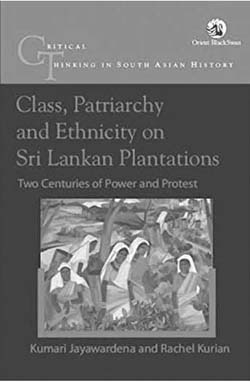by V. Suryanarayan, ‘The Book Review India,’ March 2016

CLASS, PATRIARCHY AND ETHNICITY ON SRI LANKAN PLANTATIONS: TWO CENTURIES OF POWER AND PROTEST
By Kumari Jayawardena and Rachel Kurian
Orient BlackSwan, Hyderabad, 2015, pp. 364, Rs. 825.00
VOLUME XL NUMBER 3 March 2016
The book traces two centuries old history of plantations in Sri Lanka from its inception in the early 19th century to the present. In doing so the book highlights the complex interrelationship between power and class, gender and ethnic hierarchies. The authors are well known social scientists and have already made a mark as perceptive writers on Sri Lankan history and politics. Based on their rich experience, coupled with extensive use of archival and secondary sources and enriched by personal interviews with key players the book is an invaluable contribution to Sri Lankan history and politics. It is history writing at its best. Divided into seven parts, the first deals with the legacy of slavery. Even though slavery was abolished in the British colonies, a ‘new form of slavery’, to use Hugh Tinker’s picturesque phrase, came into existence. The second part deals with the role of the outsiders—bureaucrats, political leaders, trade union activists and civil society organizations, who tried to bring about improvement in the living conditions of the workers. The third section deals with labour resistance—the heroic struggle of the workers for a better life. The fourth part is devoted to the struggle for getting citizenship and democratic rights. The fifth part analyses the impact of the ethnic conflict in the plantation areas. Though the hill country Tamils did not subscribe to the goal of a separate state of Tamil Eelam and their representative organization—Ceylon Workers Congress—was a partner in the Sinhalese-dominated governments, these innocent people were subjected to vicious and savage attacks by the lumpen sections of the Sinhalese in 1977, 1981 and 1983. The sixth part deals with patriarchy, which influenced all aspects of plantation life. The seventh section highlights the achievements of the plantation community in terms of social justice and human development. The agony and suffering undergone by the Indian coolies under the British Raj and the Planters Raj are innumerable. The verdant carpet of green in the central parts of the island, which has made Sri Lanka the veritable ‘island paradise’, was due to the sweat and agony of the Indian Tamil plantation workers. I would like to give two contrasting vignettes of the affluent planters and the impoverished workers. While teaching in the Peradeniya University in Sri Lanka a few years ago, I came across the memoirs of Philip Crowe, US Ambassador … http://www.thebookreviewindia.org/articles/archives-4887/2016/March/3/the-other-tamils-of-sri-lanka.html